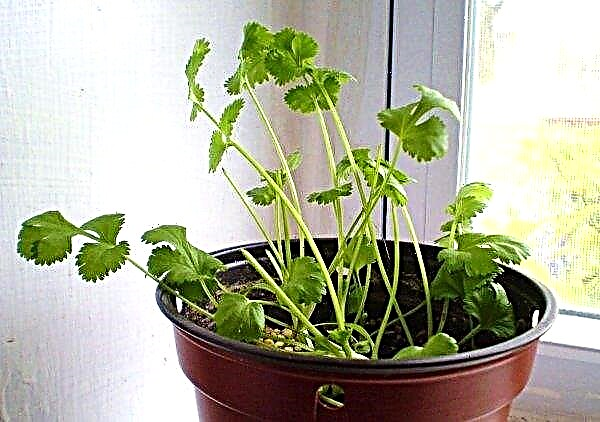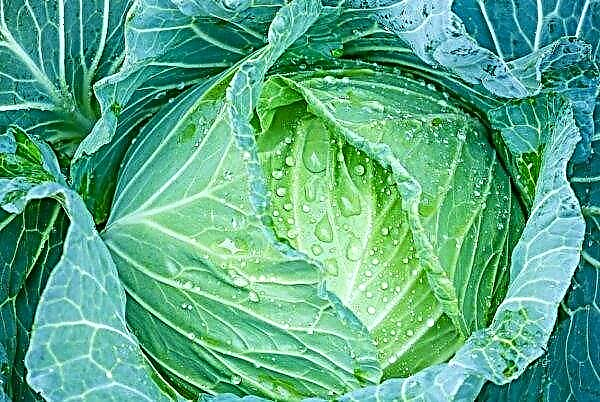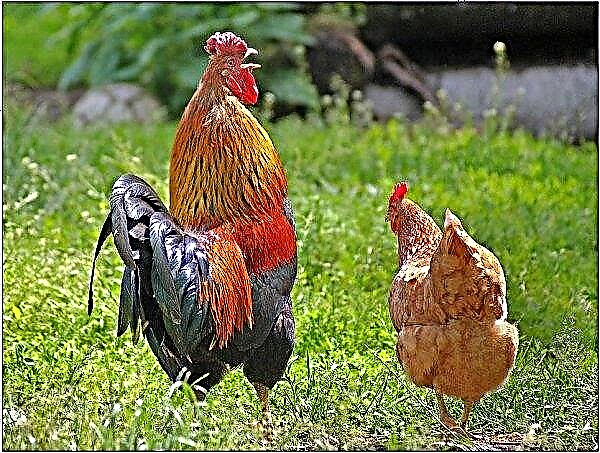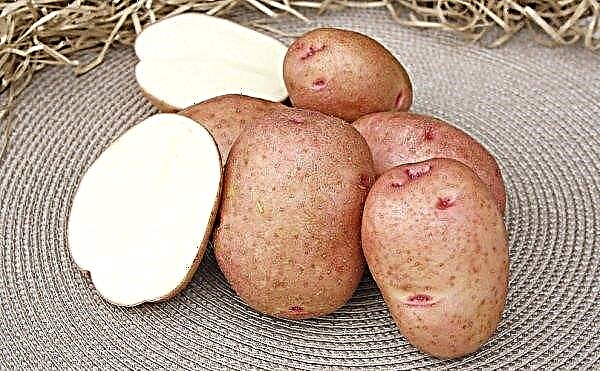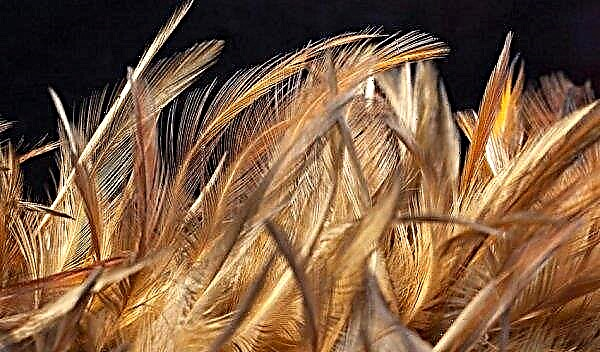Often in the garden plots you can find patients affected by pests. Instead of luxurious motley flowers there are frail, curved stems. The reason for this may be thrips. Why thrips appear on gladioli and whether an effective fight against them is possible will be considered in the article.
Who are thrips
Thrips - Taeniothrips simplex Moris - a small winged insect 1.5 mm long. Culture affects both adults and larvae. He punctures plant tissue and drinks juice from stems and leaves.
During the breeding season, the female lays 20-30 eggs. Under optimal weather conditions (above + 10 ° C), the insect develops in an adult in 15–20 days. Up to 9 generations can develop in a season.Did you know? Thrips have a biological enemy — bed bugs: they eat pests with great pleasure. Accordingly, the biological balance works perfectly in the garden: thrips – bed bugs – birds.
A pest can hit a plant at any time of the year. The lesion is recognized simply: whitish spots appear on the leaves, after which they dry out. When flowering begins, thrips penetrates and affects inflorescences. A severely affected flower may not open. As soon as the temperature drops below + 10 ° C, the insect crawls onto the stem, and then under the scales of the corms. If you do not get rid of the pest on time, when storing the bulb, the insect sucks out all the juices and it dries.
There are several varieties of thrips:
- Tobacco onion. Despite its name, this oblong pest does not live on tobacco. And his second name - onion, he received because this insect was often found on bulb plantings in greenhouses. A larva from a laid egg appears after 3-5 days. In unprotected soil it is dangerous for flower and decorative crops.
- Decorative. Pest that affects mainly ornamental plants. It is rare in greenhouse conditions.
- Western California Floral. An unsafe pest that can suck out all the juice from a flower. The risk of infection increases in hot weather. It affects more than 250 types of crops.
- Black-haired. The body length of an adult insect is 0.8–1 mm. The wing is underdeveloped, sometimes completely absent.
- Pea. It affects the tops of sprouts, beans, peas.

What to do if gladiolus thrips
If all the precautions did not bring the proper result and signs of the pest appeared on the gladiolus, urgent action must be taken. The pest, in addition to depletion of the vitality of the plant, can bring a dangerous disease.
Did you know? In ancient Rome, gladiolus was considered a magical plant. The onions of this flower were worn by gladiators on their chests for victory.
For this reason, the following steps are immediately taken:
- Provide uniform watering of flowers and row-spacing, because the first foci of thrips appear in dry places.
- Plantings are treated every 7-10 days with “Karbofosom” (10% solution).
- If thrips began to multiply intensively and infected the flower completely, you need to cut it. In this way, the movement of the pest to the lower part of the stem can be prevented.

Remedies for thrips on gladioli
The fight against thrips involves the use of chemicals.
Spraying with the following chemicals will help to get rid of them:
- "Actellicus";
- Decis.
- Inta-Vir;
- "Karate";
- "Karbofos";
- Confidor
- "Fitoform".
It is better to spray the plant in warm, calm weather in the early morning. On cool rainy days, you should not fight the pest, since it does not move on the surface, and processing will be ineffective. You can get rid of a flower from thrips in folk ways.
Important! To make the treatment effective, it is recommended to alternate insecticides.
According to gardeners, a plant can be cured with such safe means:
- Garlic. Before planting, withstand corms for 2–3 hours in garlic juice.
- Alcohol. In the container where the bulbs are stored, put a tissue section, richly soaked in alcohol, and tightly close for several hours. Disposal is simple: due to a lack of oxygen, the pest crawls out and dies.
- Tobacco dust and shag. You can save the gladiolus by spraying it with the infusion of these substances.
Video: the fight against thrips on gladioli
How to treat gladioli from thrips during flowering
Aggressive chemicals can spray the flower only until the arrow is fired. As soon as this happens, you need to use other drugs. The pest creeps into the bud and drinks the juice there, so you should look at the gladiolus more closely. It is the flowers that clearly show whether the plant is infected with thrips.
Important! During the flowering period, the saturation of the preparations is reduced by 1/3.
When flowering, the gladiolus is sprayed with gentle preparations:
- Fitoverm, ke;
- Inta-Vir;
- "Actellicus";
- Iskra-bio;
- "Decis";
- "Karate";
- Confidor
- infusion of garlic;
- tobacco solution;
- infusion of shag.

How to treat thrips bulbs
Bulbs should be treated before planting. But even before leaving for storage, the tubers are carefully examined. Corrupted specimens are postponed and subsequently destroyed. In order for the gladiolus tuber to produce a healthy plant for the next season, it must be treated with Karbofos (40 g per bucket of water). The bulb is placed in a solution for 30-40 minutes. After that, you need to rinse it with clean water, dry it and put it in the refrigerator. Bulbs are stored at a temperature of + 5 ... + 7 ° C.
To prevent thrips, you can do this: soak the tubers for 5 minutes in hot (+ 50 ° C) water and then dry well. The temperature regime when processing a tuber is very important, otherwise it may “cook”. If such a measure seems insufficient, the bulbs can be sprinkled with "Dichlorvos" or any insect spray. Tubers are wrapped in a bag, the drug is sprayed there, tightly closed and left for 30-60 minutes.Video: processing of gladiolus bulbs
It will be useful to treat in the spring, before planting. Tubers are picked and pickled. For a flower such as gladiolus, Fitosporin-K is suitable. It will also help protect the flower from bacterial ailments.
Did you know? In the Middle Ages, the gladioli tubers were ground and added to the flour when baking bread.
How to handle the outside of thrips
Bulb processing is the main method of controlling thrips. However, if the flower began to look bad, it must be checked for pests. If insects are found, you should immediately cut off the upper part so that they do not have time to move down.
If signs of insects are found further, it is necessary to treat the flower with a solution of copper oxychloride (30 g per 10 l of water). The next year, gladioli cannot be planted on this site.
Prevention of other pests
So that gladioli have a healthy appearance and look like in a bright photo, you should take care of them all season.
To obtain a healthy plant, a number of simple, but very important rules are observed:
- Correct crop rotation. Gladioli cannot be planted in one place for more than two years in a row.
- Change of cultures. You can save the soil on which gladioli used to grow, by planting phytoncid annuals on it, for example, nasturtium or calendula.
- Good airing of landings. The pest will not infect the plant in a bright, ventilated area.
- Preventive spraying. The invasion and development of pest colonies will be prevented by treating the plant with garlic solution (5 g per ½ bucket of water).
- Tillage. It is important not only at the beginning, before planting, but also in the fall. Well proven is such a tool as a solution of potassium permanganate.
- The cleanliness of the site. In autumn, you must remove all plant debris and burn them. The soil itself is well dug up and mulched with peat, sawdust or straw.
- Good neighbors. It is not recommended to grow gladiolus near crops from which the flower can become sick. It can be chrysanthemums, lilies, asters. Between plantings, you can plant garlic.
- In time to remove tubers for the winter. They should be dug up until the average daily temperature is set at + 10 ° C. Then the adult pest does not have time to move to the tuber and remains on the shoots and leaves.

Gladioli are considered the real gem of any flower garden. In order for the flower to be healthy, it should be timely treated from thrips. The main principle is the timely elimination of the insect and prevention - then no pest can harm the flower garden.


